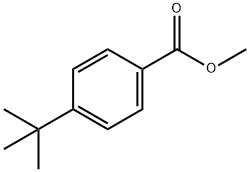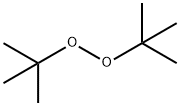tert-Butyl hydroperoxide , 70 , 75-91-2
Synonym(s):
1,1-Dimethylethyl hydroperoxide;2-Hydroperoxy-2-methylpropane;TBHP
CAS NO.:75-91-2
Empirical Formula: C4H10O2
Molecular Weight: 90.12
MDL number: MFCD00002130
EINECS: 200-915-7
PRODUCT Properties
| Melting point: | -2.8 °C |
| Boiling point: | 37 °C (15 mmHg) |
| Density | 0.937 g/mL at 20 °C |
| vapor pressure | 62 mmHg at 45 °C |
| refractive index | n |
| Flash point: | 85 °F |
| storage temp. | 2-8°C |
| form | Liquid |
| pka | pK1: 12.80 (25°C) |
| color | Clear colorless |
| PH | 4.3 |
| Water Solubility | Miscible |
| Merck | 14,1570 |
| BRN | 1098280 |
| Exposure limits | No exposure limit is set. On the basis
of its irritant properties a ceiling limit of
1.2 mg/m3 (0.3 ppm) is recommended. |
| Stability: | Stable, but may explode if heated under confinement. Decomposition may be accelerated by traces of metals, molecular sieve or other contaminants. Incompatible with reducing agents, combustible material, acids. |
| InChIKey | CIHOLLKRGTVIJN-UHFFFAOYSA-N |
| LogP | 1.230 (est) |
| CAS DataBase Reference | 75-91-2(CAS DataBase Reference) |
| NIST Chemistry Reference | Tert-butyl hydroperoxide(75-91-2) |
| EPA Substance Registry System | tert-Butyl hydroperoxide (75-91-2) |
Description and Uses
Tert-butyl hydroperoxide is an alkyl hydroperoxide in which the alkyl group is tert-butyl. It is widely used in a variety of oxidation processes. It has a role as an antibacterial agent and an oxidising agent.
TBHP is an intermediate in the production of propylene oxide and t-butyl alcohol from isobutane and propylene. It is primarily used as an initiator and finishing catalyst in the solution and emulsion polymerization methods for polystyrene and polyacrylates. Other uses are for the polymerization of vinyl chloride and vinyl acetate and as an oxidation and sulfonation catalyst in bleaching and deodorizing operations. It is a strong oxidant and reacts violently with combustible and reducing materials, and metallic and sulfur compounds.
Safety
| Symbol(GHS) |       GHS02,GHS05,GHS06,GHS07,GHS08,GHS09 |
| Signal word | Danger |
| Hazard statements | H311-H330-H371-H372-H373-H226-H242-H302-H311+H331-H314-H317-H341-H411-H304-H336-H410-H300-H310-H318 |
| Precautionary statements | P220-P261-P273-P280-P305+P351+P338-P310-P210-P234-P301+P310-P303+P361+P353-P304+P340+P310-P331-P403+P233-P201-P202-P233-P240-P241+P242+P243-P260-P264-P270-P271-P272-P284-P301+P330+P331+P310-P303+P361+P353+P310+P363-P301+P310a-P304+P340-P320-P405-P410-P501a |
| Hazard Codes | O,C,N,T |
| Risk Statements | 7-10-20/21/22-34-65-52/53-43-67-53-68-51/53-23-21/22 |
| Safety Statements | 14-3/7-61-45-36/37/39-24-17-16-14A-26-62-47-43 |
| RIDADR | UN 3109 5.2 |
| WGK Germany | 3 |
| RTECS | EQ4900000 |
| F | 3-21 |
| Autoignition Temperature | Self-accelerating decomposition at 88 to 93 °C |
| TSCA | Yes |
| HazardClass | 5.2 |
| PackingGroup | II |
| HS Code | 29094990 |
| Hazardous Substances Data | 75-91-2(Hazardous Substances Data) |
| Toxicity | LD50 oral (rat) 406 mg/kg LD50 skin (rabbit) 460 mg/kg LC50 inhal (rat) 500 ppm (4 h) |




